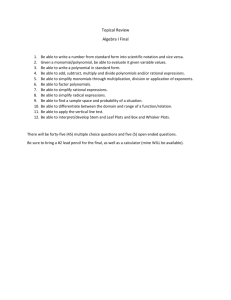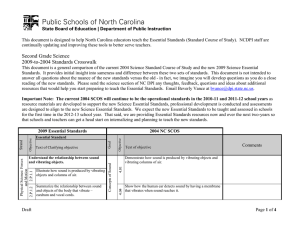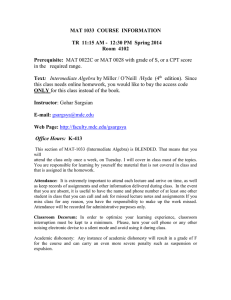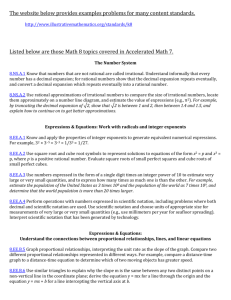This document is designed to help North Carolina educators teach...
advertisement
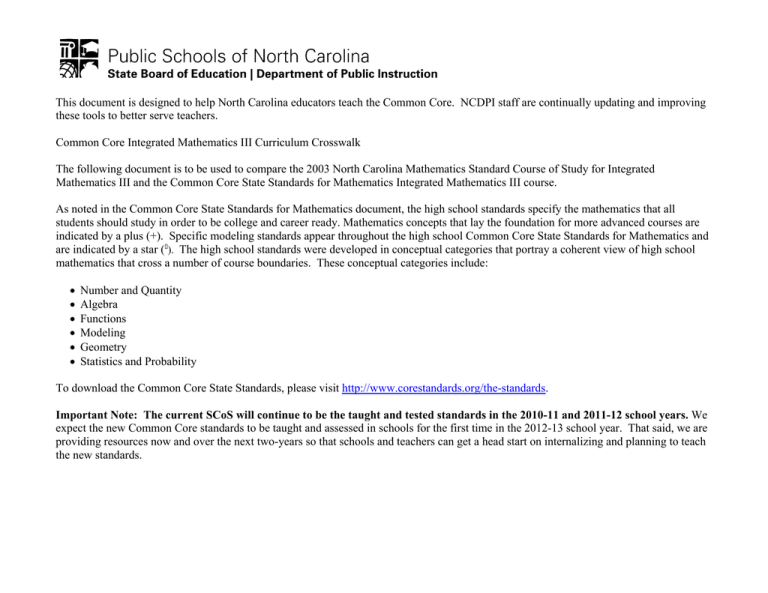
This document is designed to help North Carolina educators teach the Common Core. NCDPI staff are continually updating and improving these tools to better serve teachers. Common Core Integrated Mathematics III Curriculum Crosswalk The following document is to be used to compare the 2003 North Carolina Mathematics Standard Course of Study for Integrated Mathematics III and the Common Core State Standards for Mathematics Integrated Mathematics III course. As noted in the Common Core State Standards for Mathematics document, the high school standards specify the mathematics that all students should study in order to be college and career ready. Mathematics concepts that lay the foundation for more advanced courses are indicated by a plus (+). Specific modeling standards appear throughout the high school Common Core State Standards for Mathematics and are indicated by a star (�). The high school standards were developed in conceptual categories that portray a coherent view of high school mathematics that cross a number of course boundaries. These conceptual categories include: • • • • • • Number and Quantity Algebra Functions Modeling Geometry Statistics and Probability To download the Common Core State Standards, please visit http://www.corestandards.org/the-standards. Important Note: The current SCoS will continue to be the taught and tested standards in the 2010-11 and 2011-12 school years. We expect the new Common Core standards to be taught and assessed in schools for the first time in the 2012-13 school year. That said, we are providing resources now and over the next two-years so that schools and teachers can get a head start on internalizing and planning to teach the new standards. Common Core Crosswalk Document HS Math: Common Core Integrated Mathematics III Standard Text of objective Common Core Domain Objective Strand NC SCOS 1.01 Comments A.SSE.1 A.APR.6 Arithmetic with Polynomials and Rational Expressions Polynomial and rational Interpret the structure of expressions Interpret expressions that represent a quantity in terms of expressions are the expectation at this level. its context.� b. Interpret complicated expressions by viewing one or more of their parts as a single entity. For example, interpret P(1+r)n as the product of P and a factor not depending on P. Interpret the structure of expressions A.SSE.2 Numbers & Operations Text of objective Polynomial and rational Interpret the structure of expressions Interpret expressions that represent a quantity in terms of expressions are the expectation at this level. its context.� a. Interpret parts of an expression, such as terms, factors, and coefficients. Seeing Structure in Expressions Write equivalent forms of algebraic expressions to solve problems Cluster Use the structure of an expression to identify ways to rewrite it. For example, see x4 – y4 as (x2)2 – (y2)2, thus recognizing it as a difference of squares that can be factored as (x2 – y2)(x2 + y2). Rewrite rational expressions Rewrite simple rational expressions in different forms; write a(x)/b(x) in the form q(x) + r(x)/b(x), where a(x), b(x), q(x), and r(x) are polynomials with the degree of r(x) less than the degree of b(x), using inspection, long division, or, for the more complicated examples, a computer algebra system. NC DPI Page 2 of 15 3/31/2011 Polynomial and rational expressions are the expectation at this level. Common Core Crosswalk Document HS Math: Common Core Integrated Mathematics III Simplify and perform operations with rational exponents and logarithms to solve problems. Domain Standard A.SSE.4 F.LE.4 Use algebraic expressions, including iterative and recursive forms to model and solve problems. Seeing Structure in Expressions Text of objective Common Core Linear, Quadratic, and Exponential Models� Objective 2.01 2.02 Geometry and Measurement 1.04 1.03 1.02 Strand NC SCOS Cluster Text of objective Comments Write expressions in equivalent forms to solve problems Derive the formula for the sum of a finite geometric series (when the common ratio is not 1), and use the formula to solve problems. For example, calculate mortgage payments.� Rational exponents are in Math II Construct and compare linear, quadratic, and CCSS. exponential models and solve problems For exponential models, express as a logarithm the solution to abct = d where a, c, and d are numbers and the base b is 2,10,or e; evaluate the logarithm using technology. Model and solve problems using direct, inverse, combined and joint variation. Direct variation is in middle school CCSS. Inverse variation, joint variation and combined variation are not in the CCSS. Logic problems are not explicit in in the 2003 NC SCOS; however, logic and deductive reasoning are addressed in the Mathematical Practices and embedded throughout the CCSS. Vertical and adjacent angles, and parallel lines are in the middle school CCSS. These are foundational concepts moved to Math II CCSS. Use logic and deductive reasoning to draw conclusions and solve problems. Apply properties, definitions, and theorems of angles and lines to solve problems and write proofs. NC DPI Page 3 of 15 3/31/2011 Common Core Crosswalk Document HS Math: Common Core Integrated Mathematics III Standard Domain Cluster Text of objective Comments G.SRT.11 G.SRT.9 Similarity, Right Triangles and Trigonometry Trigonometric Functions G.SRT.1 Similarity and congruence are in Math II CCSS. F.TF.1 Apply the properties, definitions, and theorems of two-dimensional figures to solve problems and write proofs: a) Triangles b) Quadrilaterals c) Other polygons d) Circles Use the law of sines and law of cosines to solve problems. Common Core Similarity, Right Triangles and Trigonometry Objective 2.03 Text of objective 2.04 Strand NC SCOS Apply trigonometry to general triangles (+) Prove the Laws of Sines and Cosines and use them to solve problems. Apply trigonometry to general triangles (+) Understand and apply the Law of Sines and the Law of Cosines to find unknown measurements in right and non-right triangles (e.g., surveying problems, resultant forces). Moved from fourth courses in the Apply trigonometry to general triangles (+) Derive the formula A = 1/2 ab sin(C) for the area of a 2003 NC SCOS. triangle by drawing an auxiliary line from a vertex perpendicular to the opposite side. Extend the domain of trigonometric functions using the unit circle Understand radian measure of an angle as the length of the arc on the unit circle subtended by the angle. NC DPI Page 4 of 15 3/31/2011 Moved from fourth courses in the 2003 NC SCOS. Common Core Crosswalk Document HS Math: Common Core Integrated Mathematics III Cluster Text of objective Comments Moved from fourth courses in the Extend the domain of trigonometric functions using 2003 NC SCOS. the unit circle Explain how the unit circle in the coordinate plane enables the extension of trigonometric functions to all real numbers, interpreted as radian measures of angles traversed counterclockwise around the unit circle. G.MG.1 Not explicit in the 2003 NC Apply geometric concepts in modeling situations Use geometric shapes, their measures, and their properties SCOS. to describe objects (e.g., modeling a tree trunk or a human torso as a cylinder).� G.MG.2 Visualize relationships between two-dimensional and Moved from fourth courses in the 2003 NC SCOS. three- dimensional objects Identify the shapes of two-dimensional cross-sections of three- dimensional objects, and identify three-dimensional objects generated by rotations of two-dimensional objects. Apply geometric concepts in modeling situations Apply concepts of density based on area and volume in modeling situations (e.g., persons per square mile, BTUs per cubic foot).� G.MG.3 Modeling with Geometry G.GMD.4 F.TF.2 Standard Domain Text of objective Common Core Geometric Measurement and Dimension Objective Strand NC SCOS New to CCSS. Apply geometric concepts in modeling situations Apply geometric methods to solve design problems (e.g., designing an object or structure to satisfy physical constraints or minimize cost; working with typographic grid systems based on ratios).� NC DPI Page 5 of 15 3/31/2011 New to CCSS. Common Core Crosswalk Document HS Math: Common Core Integrated Mathematics III A.CED.3 Standard Domain Cluster Text of objective Create equations that describe numbers or relationships Represent constraints by equations or inequalities, and by systems of equations and/or inequalities, and interpret solutions as viable or non- viable options in a modeling context. For example, represent inequalities describing nutritional and cost constraints on combinations of different foods. Comments Matrix operations are in fourth courses of the CCSS. Equations using all types of expressions including simple root functions are the expectation at this level. A.REI.2 Moved to IM I and IM II CCSS. F.IF.7 Use quadratic functions and inequalities to model and solve problems; justify results. a) Solve using tables, graphs, and algebraic properties. b) Interpret the constants Use rational equations to model and solve problems; justify results. a) Solve using tables, graphs, and algebraic properties. b) Interpret the constants and coefficients in the context of the problem. c) Identify the asymptotes and intercepts graphically and algebraically. Creating Equations� Use systems of two or more equations or inequalities to model and solve problems; justify results. Solve using tables, graphs, matrix operations, and algebraic properties. Reasoning with Equations and Inequalities Text of objective Common Core Interpreting Functions Objective 3.02 3.03 Data Analysis & Probability 3.01 Strand NC SCOS Understand solving equations as a process of reasoning and explain the reasoning Solve simple rational and radical equations in one variable, and give examples showing how extraneous solutions may arise. One-variable rational and radical equations are new to CCSS. Analyze functions using different representations Graph functions expressed symbolically and show key features of the graph, by hand in simple cases and using technology for more complicated cases.� b. Graph square root, cube root, and piecewisedefined functions, including step functions and absolute value functions. Using technology for more difficult cases is new to CCSS. Includes rational and radical functions with a focus on using key features to guide selection of appropriate type of model function. NC DPI Page 6 of 15 3/31/2011 Common Core Crosswalk Document HS Math: Common Core Integrated Mathematics III Standard Text of objective Common Core Domain Objective 3.04 Strand NC SCOS Cluster Text of objective Comments Analyze functions using different representations Graph functions expressed symbolically and show key features of the graph, by hand in simple cases and using technology for more complicated cases.� c. Graph polynomial functions, identifying zeros when suitable factorizations are available, and showing end behavior. Using technology for more difficult cases is new to CCSS. Analyze functions using different representations Graph functions expressed symbolically and show key features of the graph, by hand in simple cases and using technology for more complicated cases.� e. Graph exponential and logarithmic functions, showing intercepts and end behavior, and trigonometric functions, showing period, midline, and amplitude. Using technology for more difficult cases is new to CCSS. Includes rational and radical functions with a focus on using key features to guide selection of appropriate type of model function. Use equations and inequalities with absolute value to model and solve problems; justify results. a) Solve using tables, graphs, and algebraic properties. b) Interpret the constants and coefficients in the context of the problem. Moved to IM II CCSS. NC DPI Page 7 of 15 3/31/2011 Common Core Crosswalk Document HS Math: Common Core Integrated Mathematics III Standard Domain Cluster Text of objective Comments Including simple radical, rational, and exponential functions with an Identify the effect on the graph of replacing f(x) by f(x) + emphasis on the common effect k, k f(x), f(kx), and f(x + k) for specific values of k (both of each transformation across the positive and negative); find the value of k given the function types is the expectation graphs. Experiment with cases and illustrate an at this level. explanation of the effects on the graph using technology. Include recognizing even and odd functions from their graphs and algebraic expressions for them. A.CED.1 Creating Equations� Reasoning with Equations and Inequalities F.BF.3 Build new functions from existing functions Create equations that describe numbers or relationships Create equations and inequalities in one variable and use them to solve problems. Include equations arising from linear and quadratic functions, and simple rational and exponential functions. One-variable equations and inequalities are new to CCSS. Equations using all types of expressions including simple root functions are the expectation at this level. New to CCSS. Combining polynomial, rational, radical, absolute value, and Explain why the x-coordinates of the points where the exponential functions are the graphs of the equations y = f(x) and y = g(x) intersect are expectations at this level. the solutions of the equation f(x) = g(x); find the solutions approximately, e.g., using technology to graph the functions, make tables of values, or find successive approximations. Include cases where f(x) and/or g(x) are linear, polynomial, rational, absolute value, exponential, and logarithmic functions.� Represent and solve equations and inequalities graphically A.REI.11 Transform functions in two dimensions; describe the results algebraically and geometrically. Common Core Building Functions Objective Text of objective 3.05 Strand NC SCOS NC DPI Page 8 of 15 3/31/2011 Common Core Crosswalk Document HS Math: Common Core Integrated Mathematics III S.IC.3 S.IC.2 S.IC.1 S.ID.4 Standard Domain Interpreting Categorical and Quantitative Data Text of objective Common Core Making Inferences and Justifying Conclusions Objective Strand NC SCOS Cluster Text of objective Comments Summarize, represent, and interpret data on a single count or measurement variable Use the mean and standard deviation of a data set to fit it to a normal distribution and to estimate population percentages. Recognize that there are data sets for which such a procedure is not appropriate. Use calculators, spreadsheets, and tables to estimate areas under the normal curve. Moved from fourth courses in the 2003 NC SCOS. Understand and evaluate random processes underlying statistical experiments Understand statistics as a process for making inferences about population parameters based on a random sample from that population. Moved from fourth courses in the 2003 NC SCOS. Moved from fourth courses in the Understand and evaluate random processes 2003 NC SCOS. underlying statistical experiments Decide if a specified model is consistent with results from a given data-generating process, e.g., using simulation. For example, a model says a spinning coin falls heads up with probability 0.5. Would a result of 5 tails in a row cause you to question the model? Make inferences and justify conclusions from sample Moved from fourth courses in the 2003 NC SCOS. surveys, experiments, and observational studies Recognize the purposes of and differences among sample surveys, experiments, and observational studies; explain how randomization relates to each. NC DPI Page 9 of 15 3/31/2011 Common Core Crosswalk Document HS Math: Common Core Integrated Mathematics III Algebra Standard S.MD.6 S.MD.7 The Complex Number System N.CN.8 Using Probability to Make Decisions S.IC.6 S.IC.5 S.IC.4 Text of objective Common Core Domain Objective Strand NC SCOS Cluster Text of objective Comments Make inferences and justify conclusions from sample Moved from fourth courses in the 2003 NC SCOS. surveys, experiments, and observational studies Use data from a sample survey to estimate a population mean or proportion; develop a margin of error through the use of simulation models for random sampling. Make inferences and justify conclusions from sample surveys, experiments, and observational studies Use data from a randomized experiment to compare two treatments; use simulations to decide if differences between parameters are significant. Moved from fourth courses in the 2003 NC SCOS. Make inferences and justify conclusions from sample surveys, experiments, and observational studies Evaluate reports based on data. Moved from fourth courses in the 2003 NC SCOS. Moved from fourth courses in the Use probability to evaluate outcomes of decisions (+) Use probabilities to make fair decisions (e.g., drawing 2003 NC SCOS. More complex situations are the by lots, using a random number generator). expectation at this level. Moved from fourth courses in the Use probability to evaluate outcomes of decisions 2003 NC SCOS. (+) Analyze decisions and strategies using probability concepts (e.g., product testing, medical testing, pulling a hockey goalie at the end of a game). Use complex numbers in polynomial identities and equations (+) Extend polynomial identities to the complex numbers. For example, rewrite x2 + 4 as (x + 2i)(x – 2i). NC DPI Page 10 of 15 3/31/2011 New to CCSS. Polynomials with real number coefficients is the expectation at this level. Common Core Crosswalk Document HS Math: Common Core Integrated Mathematics III A.APR.4 A.APR.3 A.APR.2 A.APR.1 N.CN.9 Standard Domain Text of objective Common Core Arithmetic with Polynomials and Rational Expressions Objective Strand NC SCOS Cluster Text of objective Comments Use complex numbers in polynomial identities and equations (+) Know the Fundamental Theorem of Algebra; show that it is true for quadratic polynomials. New to CCSS. Polynomials of higher degree are the expectation at this level. Perform arithmetic operations on polynomials Understand that polynomials form a system analogous to the integers, namely, they are closed under the operations of addition, subtraction, and multiplication; add, subtract, and multiply polynomials. Moved from 2003 IM I and IM II NC SCOS. Polynomials that simplify beyond quadratics is the expectation at this level. Understand the relationship between zeros and factors of polynomials Know and apply the Remainder Theorem: For a polynomial p(x) and a number a, the remainder on division by x – a is p(a), so p(a) = 0 if and only if (x – a) is a factor of p(x). Remainder theorem is not explicit in the fourth courses of the 2003 NC SCOS; therefore, it is new to CCSS. Understand the relationship between zeros and factors of polynomials Identify zeros of polynomials when suitable factorizations are available, and use the zeros to construct a rough graph of the function defined by the polynomial. Identifying zeros is not new to CCSS; however, using zeros to construct a rough graph is new to CCSS. Use polynomial identities to solve problems Prove polynomial identities and use them to describe numerical relationships. For example, the polynomial identity (x2 + y2)2 = (x2 – y2)2 + (2xy)2 can be used to generate Pythagorean triples. New to CCSS. NC DPI Page 11 of 15 3/31/2011 Common Core Crosswalk Document HS Math: Common Core Integrated Mathematics III A.CED.4 A.CED.2 A.APR.7 A.APR.5 Standard Domain Text of objective Common Core Creating Equations� Objective Strand NC SCOS Cluster Text of objective Use polynomial identities to solve problems (+) Know and apply the Binomial Theorem for the expansion of (x + y)n in powers of x and y for a positive integer n, where x and y are any numbers, with coefficients determined for example by Pascal’s Triangle.1 1 The Binomial Theorem can be proved by mathematical induction or by a combinatorial argument. Comments Moved from fourth courses in the 2003 NC SCOS. Not explicit in the 2003 IM III Rewrite rational expressions NC SCOS. (+) Understand that rational expressions form a system analogous to the rational numbers, closed under addition, subtraction, multiplication, and division by a nonzero rational expression; add, subtract, multiply, and divide rational expressions. Create equations that describe numbers or relationships Create equations in two or more variables to represent relationships between quantities; graph equations on coordinate axes with labels and scales. Create equations that describe numbers or relationships Rearrange formulas to highlight a quantity of interest, using the same reasoning as in solving equations. For example, rearrange Ohm’s law V = IR to highlight resistance R. NC DPI Page 12 of 15 3/31/2011 Creating equations in more than two variables is new to CCSS. Equations using all types of expressions including simple root functions are the expectation at this level. Literal equations are not explicit in the 2003 NC SCOS. Equations using all types of expressions including simple root functions are the expectation at this level. Common Core Crosswalk Document HS Math: Common Core Integrated Mathematics III Cluster Comments Interpret functions that arise in applications in terms of the context For a function that models a relationship between two quantities, interpret key features of graphs and tables in terms of the quantities, and sketch graphs showing key features given a verbal description of the relationship. Key features include: intercepts; intervals where the function is increasing, decreasing, positive, or negative; relative maximums and minimums; symmetries; end behavior; and periodicity.� New to CCSS. Rational, square root and cube root functions with an emphasis on selection of appropriate models are the expectation at this level. Interpret functions that arise in applications in terms of the context Relate the domain of a function to its graph and, where applicable, to the quantitative relationship it describes. For example, if the function h(n) gives the number of person-hours it takes to assemble n engines in a factory, then the positive integers would be an appropriate domain for the function.� New to CCSS. Includes rational, square root and cube root functions with an emphasis on selection of appropriate models is the expectation at this level. Interpret functions that arise in applications in terms of the context Calculate and interpret the average rate of change of a function (presented symbolically or as a table) over a specified interval. Estimate the rate of change from a graph.� Moved from fourth courses in the 2003 NC SCOS. Includes rational, square root and cube root functions with an emphasis on selection of appropriate models is the expectation at this level. F.IF.6 F.IF.4 Text of objective F.IF.5 Standard Domain Text of objective Common Core Interpreting Functions Objective Strand NC SCOS NC DPI Page 13 of 15 3/31/2011 Common Core Crosswalk Document HS Math: Common Core Integrated Mathematics III Standard Text of objective Common Core Domain Cluster Text of objective Comments Completing the square is not explicit in the 2003 NC SCOS. Factoring has moved to IM I CCSS. Includes rational and radical functions with a focus on using key features to guide selection of appropriate type of model function. Moved from 2003 IM II NC Analyze functions using different representations Write a function defined by an expression in different but SCOS. equivalent forms to reveal and explain different properties Includes rational and radical functions with a focus on using of the function. key features to guide selection of b. Use the properties of exponents to interpret appropriate type of model expressions for exponential functions. For function. example, identify percent rate of change in functions such as y = (1.02)t, y = (0.97)t, y = (1.01)12t, y = (1.2)t/10, and classify them as representing exponential growth or decay. F.IF.8 Analyze functions using different representations Write a function defined by an expression in different but equivalent forms to reveal and explain different properties of the function. a. Use the process of factoring and completing the square in a quadratic function to show zeros, extreme values, and symmetry of the graph, and interpret these in terms of a context. F.IF.9 Objective Strand NC SCOS Analyze functions using different representations Compare properties of two functions each represented in a different way (algebraically, graphically, numerically in tables, or by verbal descriptions). For example, given a graph of one quadratic function and an algebraic expression for another, say which has the larger maximum. NC DPI Page 14 of 15 3/31/2011 New to CCSS. Includes rational and radical functions with a focus on using key features to guide selection of appropriate type of model function. Common Core Crosswalk Document HS Math: Common Core Integrated Mathematics III Cluster Comments Model periodic phenomena with trigonometric functions Choose trigonometric functions to model periodic phenomena with specified amplitude, frequency, and midline.� Moved from fourth courses in the 2003 NC SCOS. Build a function that models a relationship between two quantities Write a function that describes a relationship between two quantities.� b. Combine standard function types using arithmetic operations. For example, build a function that models the temperature of a cooling body by adding a constant function to a decaying exponential, and relate these functions to the model. Combining functions is not explicit in the 2003 NC SCOS. Including all types of functions studied is the expectation at this level. Build new functions from existing functions Find inverse functions. a. Solve an equation of the form f(x) = c for a simple function f that has an inverse and write an expression for the inverse. For example, f(x) =2 x3 or f(x) = (x+1)/(x–1) for x 1. Moved from fourth courses in the 2003 NC SCOS. Including simple radical, rational, and exponential functions with an emphasis on the common effect of each transformation across the function types is the expectation at this level. F.BF.4 F.TF.5 Text of objective F.BF.1 Standard Domain Trigonometric Functions Text of objective Common Core Building Functions Objective Strand NC SCOS NC DPI Page 15 of 15 3/31/2011



